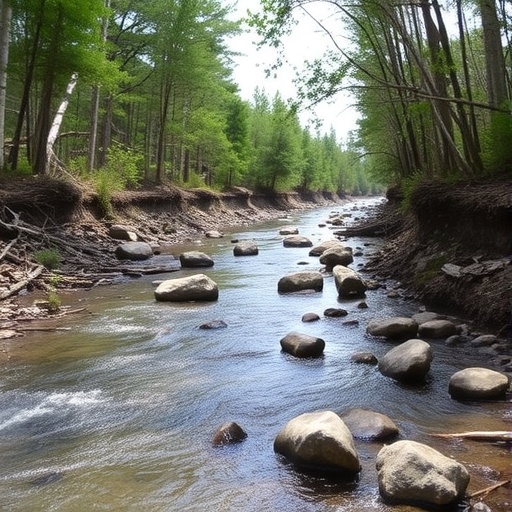In recent years, the environmental consequences of mining activities have garnered increasing attention worldwide. Particularly troubling is the mining of manganese, a metal that, while essential for many industrial processes, can have detrimental effects on ecosystems and human health when mismanaged. The ongoing restoration of the Moulili riverbed in Moanda, Gabon, showcases the complex interplay between industrial activity and environmental recovery. Researchers have embarked on a study to assess the enrichment of potentially toxic metals in restored areas affected by manganese mining. This study aims to provide insights not only into current environmental risks but also into the effectiveness of restoration efforts following industrial disruption.
Manganese mining is notorious for its ecological footprint, which can severely impact local waterways. In Moanda, the topography and soil composition in the vicinity of mining operations have undergone significant alterations. Mining activities often lead to soil erosion, habitat destruction, and the contamination of water sources with heavy metals. This particular study investigates these effects in depth, focusing on the Moulili riverbed that has experienced such environmental shifts. By analyzing sediment samples, the researchers aimed to quantify the degree of metal enrichment attributed to manganese mining and assess the potential risks associated with heavy metal exposure.
The research hinges on a meticulous process of sampling and analysis, designed to deliver reliable results regarding the levels of toxic metals such as lead, cadmium, and arsenic within the riverbed. The study employed advanced techniques, including spectrometry and chromatography, to precisely measure the concentrations of these elements. Results indicated that areas near former manganese mining operations showed significant increases in metal levels compared to non-affected regions. This has raised alarms regarding the implications for both aquatic life and local communities reliant on the river for water and other resources.
An important aspect of the study is the assessment of the enrichment factor, a mathematical expression that quantifies the increase in metal concentration relative to baseline levels. By employing this technique, the researchers were able to provide a clearer picture of how mining operations have altered the natural equilibrium of the riverbed ecosystem. The findings revealed that certain metals had accumulated in concentrations well above safe thresholds, suggesting an urgent need for remedial action and careful environmental monitoring moving forward.
Moreover, the study closely examined the implications of these findings for public health. Communities residing near the Moulili river depend on its waters for drinking, agriculture, and fishing. Elevated levels of toxic metals in the environment can lead to serious health issues, including neurological damage and developmental disorders. This raises ethical considerations regarding the responsibilities of mining companies and government agencies in safeguarding the well-being of local populations.
Restoration efforts in the Moulili riverbed form a crucial part of the research narrative. The study seeks to evaluate the effectiveness of interventions implemented to restore the natural environment after manganese mining activities. Successful restoration necessitates not only the removal of contaminants but also the reestablishment of biological diversity within the ecosystem. The researchers examined the flora and fauna present in the restored areas to ascertain whether they were recovering and how effectively they were reestablishing ecological balance.
Preventive measures and long-term strategies for industries engaged in manganese mining should also be part of the conversation. Implementing stricter regulations on mining practices, enhancing monitoring systems, and establishing rehabilitation funds are critical to mitigating future environmental damage. The study presents a compelling case for proactive management of mining sites, illustrating how preventative approaches can save ecosystems from irreversible harm.
As part of the investigation, researchers also conducted a comparative analysis of different mining sites and the subsequent restoration measures adopted. This broader perspective offers valuable lessons that can be applied to similar mining operations globally. By understanding what has worked and what has not in the context of manganese mining, policymakers and industry leaders can develop more effective strategies that prioritize environmental health alongside economic gains.
Financing environmental recovery is a significant challenge in regions like Moanda, where mining is economically vital. The study proposes innovative funding models that can support remediation projects. Collaborative efforts between government, industry, non-profits, and local communities are essential to gather the resources required for successful restoration, especially in regions suffering from chronic economic constraints exacerbated by environmental degradation.
In conclusion, the research on the Moulili riverbed presents a multifaceted examination of the impacts of manganese mining and subsequent restoration efforts. It serves as a crucial reminder of the balances that need to be struck between industrial activity and environmental stewardship. By documenting the potential hazards posed by toxic metal enrichment and assessing the effectiveness of restoration practices, the study not only raises awareness of current environmental challenges but also paves the way for more sustainable mining practices in the future.
The findings from Moanda could inform global mining practices, highlighting the importance of stringent environmental protocols and the need for ongoing research into the ecological impacts of industrial activities. As the world grapples with the pressures of resource extraction, this study underlines the critical importance of prioritizing ecological health, promoting public health, and ensuring sustainable practices that will allow both the environment and communities to thrive in harmony.
In summary, the research sheds light on how scientific inquiry can inform practical solutions to pressing environmental issues, offering a path forward for the responsible management of the Earth’s natural resources while safeguarding human health and ecological integrity.
Subject of Research: Environmental impact of manganese mining and restoration efforts in the Moulili riverbed, Moanda, Gabon.
Article Title: Restored Moulili riverbed impacted by manganese mining activity: potentially toxic metals enrichment factor and environmental risk (Moanda, Gabon).
Article References:
Abaker, M.G., BoubalA, D.S.M., Dumont, E. et al. Restored Moulili riverbed impacted by manganese mining activity: potentially toxic metals enrichment factor and environmental risk (Moanda, Gabon).
Environ Sci Pollut Res (2025). https://doi.org/10.1007/s11356-025-36839-w
Image Credits: AI Generated
DOI:
Keywords: Manganese mining, environmental impact, restoration, heavy metals, public health, ecological balance, contamination, remediation, sustainable practices, Moanda, Gabon.




